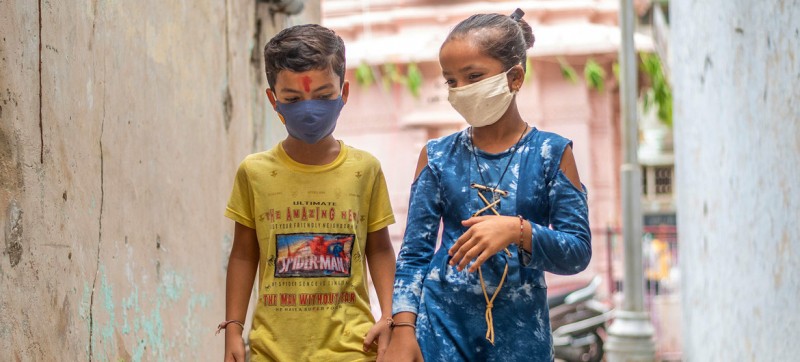A young boy and girl in India protect themselves against COVID-19 by wearing face masks. Children who have developed organ inflammation linked to COVID-19 infection should be given steroid treatment in hospital, the World Health Organization, (WHO), said on Tuesday. The updated recommendation from the UN health agency comes after it first described Multisystem Inflammatory Syndrome in Children Associated With COVID-19, or MIS-C for short, last May. “MIS-C is a rare but serious condition where children with COVID-19 develop inflammation affecting different organs of the body”, WHO spokesperson Christian Lindmeier told journalists at a scheduled briefing in Geneva.
“Children with this condition need specialized care and may need to be admitted to intensive care. Although MIS-C is a serious condition, with the right medical care, children with this condition recover”.
Most kids ‘low-risk’
Mr. Lindmeier said that although youngsters remain at a low risk of developing severe or critical COVID-19, some underlying factors make them more susceptible to developing serious organ inflammation from the coronavirus.
These conditions include obesity, chronic lung disease – including asthma – cardiovascular disease and immunosuppression.
WHO issued its recommendation after analyzing data from three observational studies that pooled the experiences of 885 patients.
COVID sweeping Europe
Meanwhile, the WHO European Region remains firmly in the pandemic’s grip. Last week, reported COVID- related deaths increased to close to 4,200 a day, doubling from 2100 deaths a day at the end of September.
And cumulative reported deaths from the virus passed the 1.5 million mark for the 53 countries in this Region.
Today, COVID-19 is the number one cause of death across Europe and central Asia, as reported by the Institute for Health Metrics and Evaluation, who carry out modelling for the WHO Regional Office for Europe.
The development comes as the UN health agency said it feared that Europe could see more than two million deaths from the coronavirus by next March.
‘Vaccine plus’ approach
“In order to live with this virus and continue our daily lives, we need to take a ‘vaccine plus’ approach”, said Hans Henri P. Kluge, WHO Regional Director for Europe.
To live with this virus and continue our daily lives, we need to take a ‘vaccine plus’ approach – WHO Director for Europe
This means getting the standard doses of vaccine, taking a booster if offered, as well as incorporating preventive measures into our normal routines.
Taken together, wearing a mask, washing hands, ventilating indoor spaces, keeping physical distance and sneezing into your elbow are simple, effective ways of gaining control over the virus and keeping societies going.
“All of us have the opportunity and responsibility to help avert unnecessary tragedy and loss of life, and limit further disruption to society and businesses over this winter season”, assured Dr. Kluge.
Worrying symptoms
Before the UN agency decided on a preliminary clinical definition of the inflammatory syndrome associated with COVID-19 last year, it had been receiving reports from Europe and North America that described clusters of children and adolescents who required intensive care treatment “with a multisystem inflammatory condition with some features similar to those of Kawasaki disease and toxic shock syndrome”.
At that time, WHO noted that patients presented “acute illness accompanied by a hyperinflammatory syndrome, leading to multi-organ failure and shock…Initial hypotheses are that this syndrome may be related to COVID-19 based on initial laboratory testing showing positive serology in a majority of patients”.
Global toll
Latest WHO data indicates that as of Monday, there have been 256, 966, 237 confirmed cases of COVID-19, including 5,151,643 deaths, reported to the agency, and a total of 7,408,870,760 vaccine doses administered.
Regionally, the Americas have recorded the highest number of infections, with more than 95 million cases, followed by Europe (83 million), South-East Asia (44 million), Eastern Mediterranean (16 million), Western Pacific (nine million) and Africa (six million).

A health worker screens a young girl for COVID-19 at a fever clinic set up next to a hospital in Saptari District , Nepal.




Comments are closed.